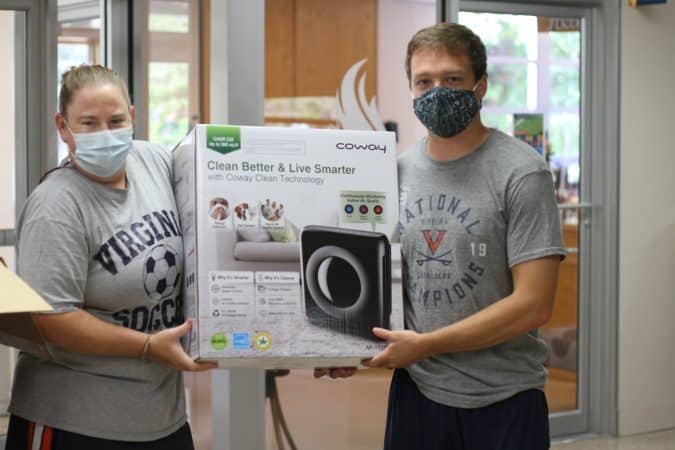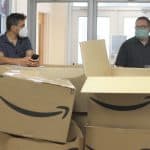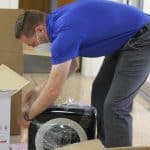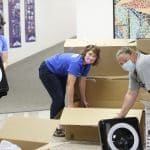Air Quality is Priority in New Year

Clean and fresh air — comfortably warmed or cooled — is important any time for optimal learning and health. But this year, with COVID-19 virus precautions, air quality is taking extra effort. Read below about the six-pronged approach EMS is taking for cleaning and circulating healthy air in our buildings this year. Mike Stoltzfus, director of business affairs, has led this effort. Pictured are faculty and staff members unpacking a shipment of air purifiers for distribution to classrooms.
In addition to the extensive planning and steps we are taking to keep teachers and students safe through physical distancing, we are also focused on safety and health through improving air quality. Here are the steps we have taken or are planning to take in the near future, and considerations impacting each:
1. Integrated bipolar ionization for larger spaces: auditorium, commons, DH, choir room
a. There may be significant lead time before these can get installed (possibly several months)
b. Depending on the cost, other spaces might be possibilities as well. Priority will be given to spaces that have had environmental issues in the past, spaces that have a higher occupant turnover, and spaces that have limited fresh air options.
2. Increased HVAC system run-time and fresh air intake
a. HVAC units are optimized to intake as much fresh air as possible without creating detrimental side effects. These possible side effects include indoor temperatures and humidity beyond the comfort level, frozen coils, and sensors tripping to prevent unit damage.
b. For rooms with rooftop units (if you have a manual thermostat in your room), you may elect to run your fan all the time if the outside humidity is within 40-60%. (Running fans while the AC compressor isn’t running will bring unconditioned air from the outside, similar to open windows, which may cause a rapid rise in humidity.)
c. For rooms controlled by the building automation system, occupancy times have been expanded to 7:00pm Sunday evening through 7pm Friday evening. This means the systems will continue to maintain preset temperatures as though the building is occupied throughout the night prior to school days.
d. Additional run time for our equipment adds wear and tear as well as increased energy consumption. Filters will also need to be changed more frequently.
3. Upgrade existing filter quality
a. HVAC filters are given MERV ratings – the higher the number, the more it filters.
b. Most of our current HVAC system filters are MERV-10, some others are MERV-7
c. Over the next week or two, we will be upgrading all filters to MERV-14
4. Stand-alone HEPA/bipolar ionization units in certain classrooms:
a. Those where students mix more (high school classrooms, primarily)
b. Those that have had environmental concerns in the past (though many of those issues have been resolved with the new roof)
c. Those that don’t have as many fresh air intake options
d. Individual air purifiers will require regular maintenance (filter changes, etc)
5. Makeshift in-room supplemental HEPA air filtering (MIRSHAF 😊)
a. Idea from this YouTube video
b. Using a 20” box fan with a MERV-14 HEPA filter, air is continuously blown through the HEPA filter, which is sealed to the box fan with tape.
c. This is a $40 solution that may have a positive impact on overall air quality in a space for little cost, though it is unknown how much or if this solution has any impact on the presence of aersolized coronavirus.
6. Opening windows:
a. Windows should ONLY be opened if the outside temperature AND humidity is close to our desired indoor environment (40-60% humidity, temps in the range of 65-75 degrees).
b. Opening windows introduces unfiltered and unconditioned air into our building (polen, etc).
c. Depending on the space and conditions, opening windows may cause the HVAC unit to run less frequently, reducing the amount of air that passes through filters.







